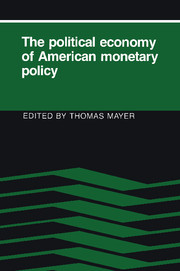Book contents
- Frontmatter
- Contents
- Preface
- List of contributors
- 1 Introduction
- 2 Studying the Fed: toward a broader public-choice perspective
- 3 The Federal Reserve reaction function: a specification search
- 4 Corporate profitability as a determinant of restrictive monetary policy: estimates for the postwar United States
- 5 Federal Reserve behavior since 1980: a financial-market perspective
- 6 The Federal Reserve and its institutional environment: a review
- 7 The political economy of monetary policy
- 8 Political monetary cycles
- 9 Congress and the Fed: why the dog does not bark in the night
- 10 The Federal Reserve as a political power
- 11 Monetary policy and political economy: the Federal Reserve and the Bank of Japan
- 12 A positive analysis of the policy-making process at the Federal Reserve
- 13 A theory of FOMC dissent voting with evidence from the time series
- 14 Explaining FOMC members' votes
- 15 Fed behavior and X-efficiency theory: toward a general framework
- 16 Minimizing regret: cognitive dissonance as an explanation of FOMC behavior
- 17 The discount window
- 18 Leaning against the wind: the behavior of the money stock in recession and recovery, 1953–8
- 19 Bureaucratic self-interest as an obstacle to monetary reform
- Index
11 - Monetary policy and political economy: the Federal Reserve and the Bank of Japan
Published online by Cambridge University Press: 06 July 2010
- Frontmatter
- Contents
- Preface
- List of contributors
- 1 Introduction
- 2 Studying the Fed: toward a broader public-choice perspective
- 3 The Federal Reserve reaction function: a specification search
- 4 Corporate profitability as a determinant of restrictive monetary policy: estimates for the postwar United States
- 5 Federal Reserve behavior since 1980: a financial-market perspective
- 6 The Federal Reserve and its institutional environment: a review
- 7 The political economy of monetary policy
- 8 Political monetary cycles
- 9 Congress and the Fed: why the dog does not bark in the night
- 10 The Federal Reserve as a political power
- 11 Monetary policy and political economy: the Federal Reserve and the Bank of Japan
- 12 A positive analysis of the policy-making process at the Federal Reserve
- 13 A theory of FOMC dissent voting with evidence from the time series
- 14 Explaining FOMC members' votes
- 15 Fed behavior and X-efficiency theory: toward a general framework
- 16 Minimizing regret: cognitive dissonance as an explanation of FOMC behavior
- 17 The discount window
- 18 Leaning against the wind: the behavior of the money stock in recession and recovery, 1953–8
- 19 Bureaucratic self-interest as an obstacle to monetary reform
- Index
Summary
The monetary experience of Japan over the past decade provides an example of a nation that has effectively stabilized its domestic inflation rate in the face of major internal and external shocks, while simultaneously avoiding recession. Japan did experience a short period of double-digit inflation around the time of the 1973 oil price shock that was higher and initially more disruptive than in the United States. However, Japan's response to that experience was the introduction in 1973 and 1974 of an explicit price stabilization strategy that quickly reduced the nation's “core inflation” to the lowest among the major industrial countries.
Four important aspects of the relative performances of the U.S. and Japanese economies since 1975 are shown in Figure 11.1. The panels on the left show that monetary growth and inflation in Japan have been more stable than in the United States. The panels on the right show that Japan has experienced a smaller degree of disruption in the real and financial sectors, as reflected by the unemployment rate and the gap between unregulated and regulated interest rates.
This chapter focuses on the differing monetary policy experiences of the United States and Japan as an explanation for the differences between the two nations' macroeconomic performances. We attempt to isolate reasons for the differences in monetary policy experiences. In particular, we argue that the differences cannot be found in the technical characteristics by which the Federal Reserve (FR) and the Bank of Japan (BOJ) formulate and execute monetary policy; rather, the differences are more fundamentally rooted in the institutional and political environments in which the two central banks operate.
- Type
- Chapter
- Information
- The Political Economy of American Monetary Policy , pp. 163 - 178Publisher: Cambridge University PressPrint publication year: 1990
- 1
- Cited by



